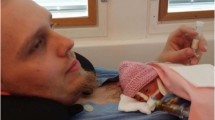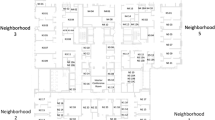Abstract
Objective
The evidence-based science of maternal and neonatal care has been rapidly changing. As a result, clinical practice and the design of physical space have evolved in order to provide neuroprotection for the baby and meet expectations of family presence and participation.
Setting
The concept and practice of NICU Couplet Care supports positive health well-being/outcomes and early relationship building between the mother-baby-father/partner.
Results
Monitoring evidence-based measures and metrics of standardized care, performance competence, neuro-physical and psychosocial outcomes, environmental design, family and staff satisfaction, and sustainability are essential to the evolution of quality, safe, efficient, effective, ethical, and cost-effective care for the mother, baby, and family.
Summary
Transparency in the dissemination of evidence, practice standards, and outcome data is important to guide parents/families and health professionals in making informed shared decisions regarding the clinical care provided and the environment where care takes place.
This is a preview of subscription content, access via your institution
Access options
Subscribe to this journal
Receive 12 print issues and online access
$259.00 per year
only $21.58 per issue
Buy this article
- Purchase on Springer Link
- Instant access to full article PDF
Prices may be subject to local taxes which are calculated during checkout
Similar content being viewed by others
Data availability
The references for the measures and/or metrics described in the manuscript and listed in Table 1 are cited.
References
Sadick B. The new NICU unit at Beacon Children’s Hospital in South Bend, Ind., facilitates close physical contact between premature babies and their parents. NY: The Wall Street Journal; 2017, Dow, Jones & Company.
Sadick B. The neonatal ICU gets a makover. New York, NY: The Wall Street Journal; 2017.
White R, and the Consensus Committee to Establish Recommended Standards of NICU Design. Recommended Standards for Newborn ICU Design, 10th ed. 2023. Available from: https://nicudesign.nd.edu/nicu-standards/.
Klemming S, Lilliesköld S, Westrup B. Mother-Newborn Couplet Care from theory to practice to ensure zero separation for all newborns. Acta Paediatr. 2021;110:2951–7.
Bergman NJ. Birth practices: maternal-neonate separation as a source of toxic stress. Birth Defects Res. 2019;111:1087–109.
van Veenendaal NR, van Kempen AAMW, Broekman BFP, de Groof F, van Laerhoven H, van den Heuvel MEN, et al. Association of a zero-separation neonatal care model with stress in mothers of preterm infants. JAMA Netw Open. 2022;5:e224514.
de Salaberry J, Hait V, Thornton K, Bolton M, Abrams M, Shivananda S, et al. Journey to mother baby care: Implementation of a combined care/couplet model in a Level 2 neonatal intensive care unit. Birth Defects Res. 2019;111:1060–72.
Stelwagen M, van Kempen A, Westmaas A, Vet E, Scheele F. Parents’ experiences with a model of integrated maternity and neonatal care designed to empower parents. J Obstet Gynecol Neonatal Nurs. 2021;50:181–92.
van Veenendaal NR, van der Schoor SRD, Broekman BFP, de Groof F, van Laerhoven H, van den Heuvel MEN, et al. Association of a family integrated care model with paternal mental health outcomes during neonatal hospitalization. JAMA Netw Open. 2022;5:e2144720.
Redshaw M, Henderson J, Bevan C. ‘This is time we’ll never get back’: a qualitative study of mothers’ experiences of care associated with neonatal death. BMJ Open. 2021;11:e050832.
Klaus P. The devil is in the details - only what gets measured gets managed. Measuring customer experience: how to develop and execute the most profitable customer experience strategies. London: Palgrave Macmillan UK; 20015.
Shepley MM, Smith JA, Sadler BL, White RD. The business case for building better neonatal intensive care units. J Perinatol. 2014;34:811–5.
O’Callaghan N, Dee A, Philip RK. Evidence-based design for neonatal units: a systematic review. Matern Health Neonatol Perinatol. 2019;5:6.
World Health Organization (WHO) Human resource strategies to improve newborn care in health facilities in low- and middle-income countries. Geneva: World Health Organization. 2020.
Curley A, Jones LK, Staff L. Barriers to couplet care of the infant requiring additional care: integrative review. Healthcare. 2023;11:737.
Brockington IF, Fraser C, Wilson D. The postpartum bonding questionnaire: a validation. Arch Womens Ment Health. 2006;9:233–42.
Perrelli JG, Zambaldi CF, Cantilino A, Sougey EB. Mother-child bonding assessment tools. Rev Paul Pediatr. 2014;32:257–65.
Erlandsson K, Dsilna A, Fagerberg I, Christensson K. Skin-to-skin care with the father after cesarean birth and its effect on newborn crying and prefeeding behavior. Birth. 2007;34:105–14.
Reynolds LC, Duncan MM, Smith GC, Mathur A, Neil J, Inder T, et al. Parental presence and holding in the neonatal intensive care unit and associations with early neurobehavior. J Perinatol. 2013;33:636–41.
Agnihotri K. Places of healing. Can Fam Physician. 2022;68:487–9.
Guyer C, Huber R, Fontijn J, Bucher HU, Nicolai H, Werner H, et al. Very preterm infants show earlier emergence of 24-hour sleep-wake rhythms compared to term infants. Early Hum Dev. 2015;91:37–42.
Susilaningshi FS, Fitri SYR, Mardhiyah A, Ermiati, Hermayanti Y. Lighting and noise levels in the neonatal intensive care unit (NICU). Indian J Public Health Res Dev. 2019;10:878.
Grigg-Damberger MM. The visual scoring of sleep in infants 0 to 2 months of age. J Clin Sleep Med. 2016;12:429–45.
Flacking R, Lehtonen L, Thomson G, Axelin A, Ahlqvist S, Moran VH, et al. Closeness and separation in neonatal intensive care. Acta Paediatr. 2012;101:1032–7.
Latour JM, Duivenvoorden HJ, Hazelzet JA, van Goudoever JB. Development and validation of a neonatal intensive care parent satisfaction instrument. Pediatr Crit Care Med. 2012;13:554–9.
Lake ET, Smith JG, Staiger DO, Schoenauer KM, Rogowski JA. Measuring parent satisfaction with care in neonatal intensive care units: the EMPATHIC-NICU-USA questionnaire. Front Pediatr. 2020;8:541573.
Franck LS, Cox S, Allen A, Winter I. Measuring neonatal intensive care unit-related parental stress. J Adv Nurs. 2005;49:608–15.
Barnes CR, Adamson-Macedo EN. Perceived Maternal Parenting Self-Efficacy (PMP S-E) tool: development and validation with mothers of hospitalized preterm neonates. J Adv Nurs. 2007;60:550–60.
Spinhoven P, Ormel J, Sloekers PP, Kempen GI, Speckens AE, Van Hemert AM. A validation study of the Hospital Anxiety and Depression Scale (HADS) in different groups of Dutch subjects. Psychol Med. 1997;27:363–70.
Vermont Oxford Network (VON). All care is brain care: gap assessment. 2023. Available from: https://public.vtoxford.org/wp-content/uploads/2022/05/Neuroprotective-Practice-Gap-Assessment.pd.
Scher MS, Ludington-Hoe S, Kaffashi F, Johnson MW, Holditch-Davis D, Loparo KA. Neurophysiologic assessment of brain maturation after an 8-week trial of skin-to-skin contact on preterm infants. Clin Neurophysiol. 2009;120:1812–8.
Pineda RG, Neil J, Dierker D, Smyser CD, Wallendorf M, Kidokoro H, et al. Alterations in brain structure and neurodevelopmental outcome in preterm infants hospitalized in different neonatal intensive care unit environments. J Pediatr. 2014;164:52–60.e2.
Lyngstad LT, Steinnes S, Le Marechal F. Improving pain management in a neonatal intensive care unit with single-family room-A quality improvement project. Paediatr Neonatal Pain. 2022;4:69–77.
van Dijk M, Roofthooft DW, Anand KJ, Guldemond F, de Graaf J, Simons S, et al. Taking up the challenge of measuring prolonged pain in (premature) neonates: the COMFORTneo scale seems promising. Clin J Pain. 2009;25:607–16.
Lester BM, Hawes K, Abar B, Sullivan M, Miller R, Bigsby R, et al. Single-family room care and neurobehavioral and medical outcomes in preterm infants. Pediatrics. 2014;134:754–60.
Ballantyne M, Stevens B, McAllister M, Dionne K, Jack A. Validation of the premature infant pain profile in the clinical setting. Clin J Pain. 1999;15:297–303.
Caskey M, Vohr B. Assessing language and language environment of high-risk infants and children: a new approach. Acta Paediatr. 2013;102:451–61.
Mazur KM, Desmadryl M, VanAntwerp K, Ziegman C, Nemshak M, Shuman CJ. Implementing evidence-informed discharge preparedness tools in the NICU: parents’ perceptions. Adv Neonatal Care. 2021;21:E111–e119.
van Veenendaal NR, Auxier JN, van der Schoor SRD, Franck LS, Stelwagen MA, de Groof F, et al. Development and psychometric evaluation of the CO-PARTNER tool for collaboration and parent participation in neonatal care. PLoS One. 2021;16:e0252074.
SHRM. SHRM’s Guide to Employee Engagement 2023. 2023; Available from: https://www.shrm.org/resourcesandtools/hr-topics/technology/pages/employee-engagement-tool.aspx.
Hagen IH, Iversen VC, Nesset E, Orner R, Svindseth MF. Parental satisfaction with neonatal intensive care units: a quantitative cross-sectional study. BMC Health Serv Res. 2019;19:37.
Rau J. Medicare to begin basing hospital payments on patient satisfaction scores. April 28, 2011. Available from: https://kffhealthcarenews.org/news/medicare-hospital-patient-satisfaction/.
Author information
Authors and Affiliations
Contributions
The authors contributed equally to this manuscript.
Corresponding author
Ethics declarations
Competing interests
The authors declare no competing interests.
Additional information
Publisher’s note Springer Nature remains neutral with regard to jurisdictional claims in published maps and institutional affiliations.
Rights and permissions
Springer Nature or its licensor (e.g. a society or other partner) holds exclusive rights to this article under a publishing agreement with the author(s) or other rightsholder(s); author self-archiving of the accepted manuscript version of this article is solely governed by the terms of such publishing agreement and applicable law.
About this article
Cite this article
Jaeger, C.B., Altimier, L. NICU Couplet Care: metrics to guide an evolving model of care. J Perinatol 43 (Suppl 1), 30–34 (2023). https://doi.org/10.1038/s41372-023-01783-5
Received:
Revised:
Accepted:
Published:
Issue Date:
DOI: https://doi.org/10.1038/s41372-023-01783-5



